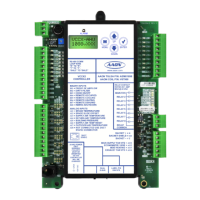35VCCX2 Controller Technical Guide
SEQUENCE OF OPERATIONS
Modes of Operation
Dehumidication Operation on Chilled Water Units
For chilled water units, the VCCX2 Controller will open the chilled
water valve to a xed 100% position to provide full moisture
removal capability.
Dehumidication Operation on Direct Expansion
Compressor Units
Any direct expansion unit doing dehumidication will utilize one or
more RSMs. Each RSM will control the compressors, condensers,
and electronic expansion valves (on VFD compressor units) for
one or two refrigeration circuits. Up to four RSMs may be used in
controlling up to eight circuits.
The RSMD is used for digital compressor units, including heat
pumps. The RSMV is used for VFD compressor units (non-heat
pumps). The RSMV-HP is used for VFD compressor units that are
heat pumps. The RSMVC-P is used for Copeland VFD compressor
units.
In the Dehumidication Mode, the compressors are controlled
to maintain the Suction (Saturation) Temperature Setpoint. Each
RSM will independently control its compressors to achieve the
most ecient dehumidication control. See the appropriate RSM
Technical Guide for a more detailed sequence of operation.
CAUTION: If the coil saturated temperature drops below 32˚F,
any cooling remaining on will be forced to stage
o.
During Dehumidification, the economizer will be held to its
minimum position. If the unit will be using the CAV/MUA Dual
Mode (hood on/o) Operation, Dehumidication will require the
use of an Outdoor and Indoor Humidity Sensor.
NOTE: Compressor operation is subject to the outdoor air
temperature cooling lockout during Dehumidication.
Reheat
During the Dehumidication Mode, the VCCX2 activates Cooling to
extract moisture from the supply air and utilizes either Modulating
Hot Gas Reheat, On/O Hot Gas Reheat, or Heating to reheat the
supply air. Hot Gas Reheat is the standard form of reheat.
Reheat is always controlled to the active Supply Air Setpoint which
will be dierent depending on whether the unit is in Cooling Mode
Dehumidication, Heating Mode Dehumidication, or Vent Mode
Dehumidication.
During Cooling Dehumidication, reheat is controlled to the active
Cooling Supply Air Setpoint. During Heating Dehumidication,
reheat is controlled to the active Heating Supply Air Setpoint.
During Vent Dehumidication, reheat is controlled to a calculated
setpoint that is halfway between the Heating and Cooling Mode
Enable Setpoints.
If the unit is equipped with a MHGRV-X, during Dehumidication it
will modulate the reheat valve to maintain the supply air temperature
at the active Supply Air Temperature Setpoint.
If the unit is equipped with an on/o hot gas valve, then one of
the relays will be congured for reheat. The reheat relay will be
activated if the supply air temperature is less than the Supply Air
Temperature Setpoint. The hot gas reheat relay will remain on during
the Dehumidication Mode regardless of the supply air temperature.
This is to ensure a steady supply air temperature.
The HVAC unit’s heat source, heat pump auxiliary heat, or a heat
source located in the supply air duct (which is used as the unit’s
heat source) can be used for reheat if the unit is not equipped with
hot gas reheat or to supplement hot gas reheat.
WARNING: Simultaneous Heating and Cooling is not
approved unless the HVAC unit has been
specifically designed for this purpose. A
Special Purchase Authorization (SPA) must
be obtained from the AAON factory for these
applications to avoid warranty and/or rating
issues.
When unit heat is used for reheat instead of hot gas reheat, the
VCCX2 can activate the heat source(s) discussed in the Heating
Mode section to maintain the supply air temperature at the active
Supply Air Temperature Setpoint. When unit heat is used to
supplement modulating hot gas reheat, the modulating hot gas
reheat signal must reach 100% before Heating will be enabled to
add additional reheat.
Coil Suction (Saturated) Temperature Reset
The indoor humidity or dewpoint can be used to reset the Coil
Saturated Temperature Setpoint. A user adjustable range of indoor
humidity or dewpoint values can be used to reset the Coil Saturated
Temperature Setpoint between a user adjustable range of values.
As the indoor humidity or dewpoint rises within its range the Coil
Saturated Temperature Setpoint will be lowered within its range.
Return Air Bypass Damper Control
The Return Air Bypass Damper is only used on CAV units with
space temperature or return air temperature congured as the
HVAC Mode Enable Sensor. The Return Air Bypass Damper is
only active during the Dehumidication Mode and is used as the
rst form of reheat. If the HVAC unit is equipped with modulating
hot gas reheat, the Return Air Bypass Damper needs to be at 100%
before the modulating hot gas reheat can be used. The Return Air
Bypass Damper modulates from 0-100% as the space (or return air)
temperature falls below the Cooling Setpoint. When the space (or
return air) temperature is equal to the Cooling Setpoint, the Return
Air Bypass Damper will be at 0%. When the space (or return air)
temperature falls to halfway between the Cooling and Heating
Setpoints, the Return Air Bypass Damper will be at 100%.

